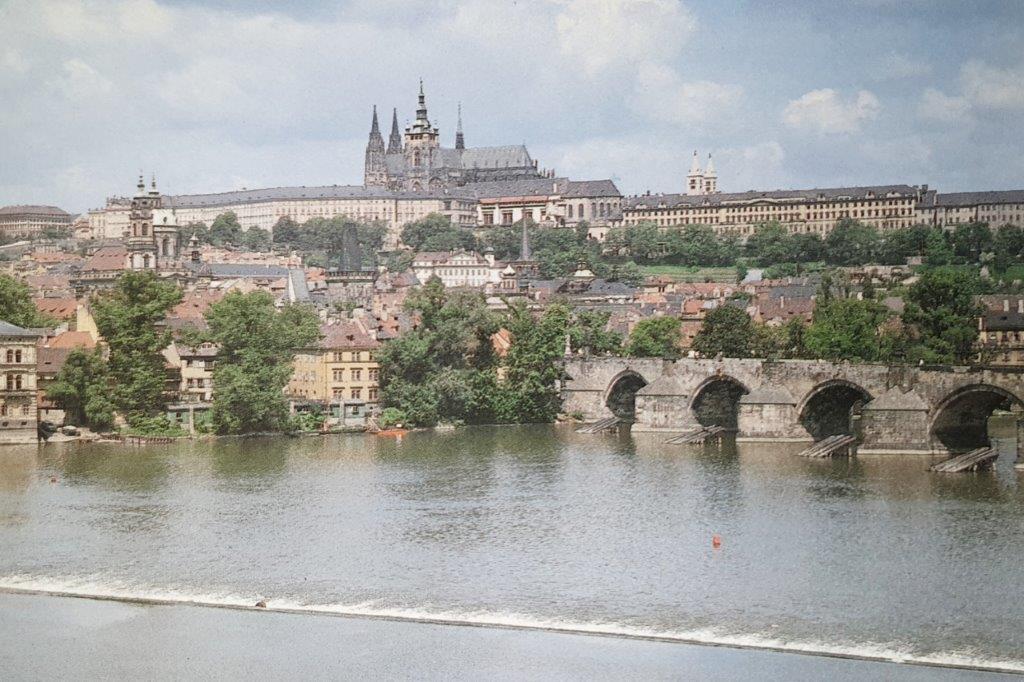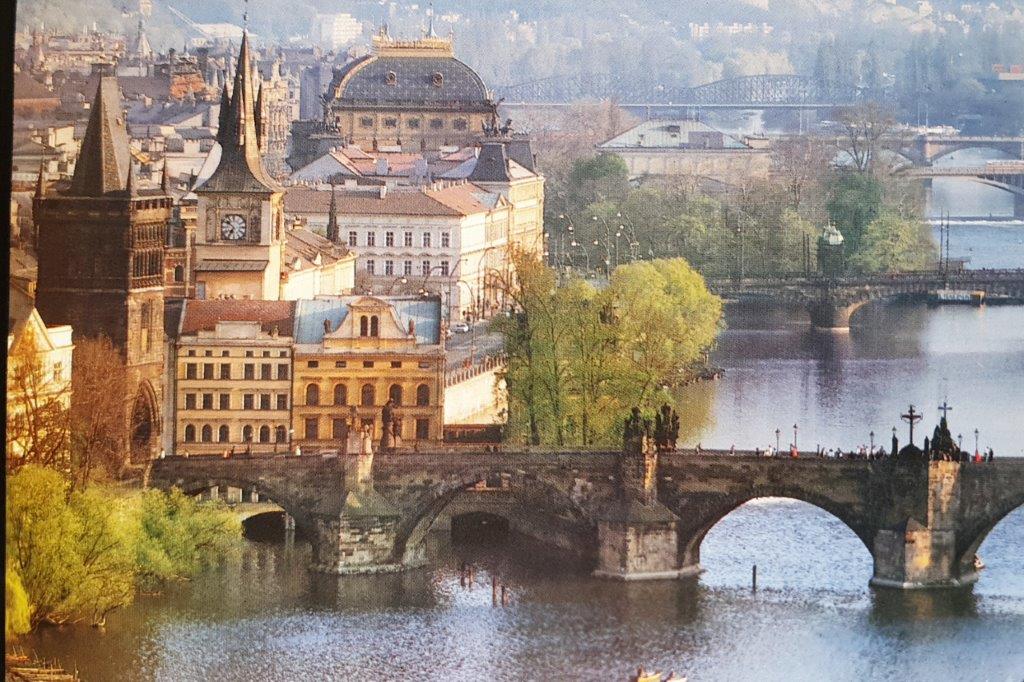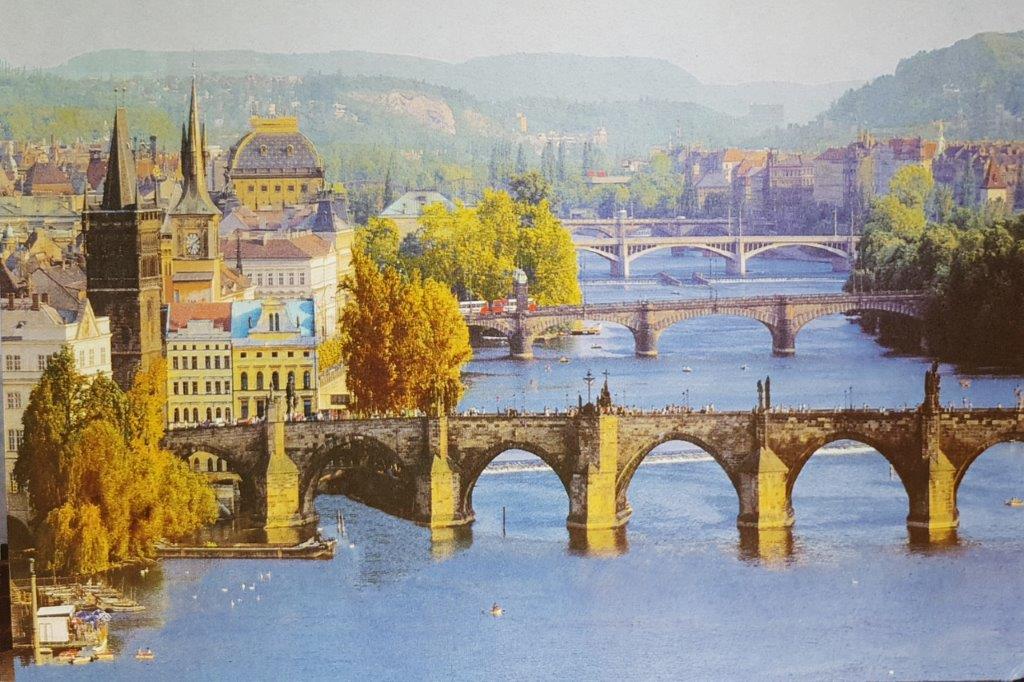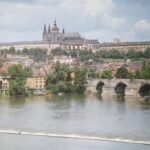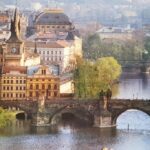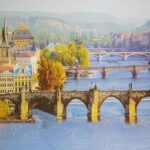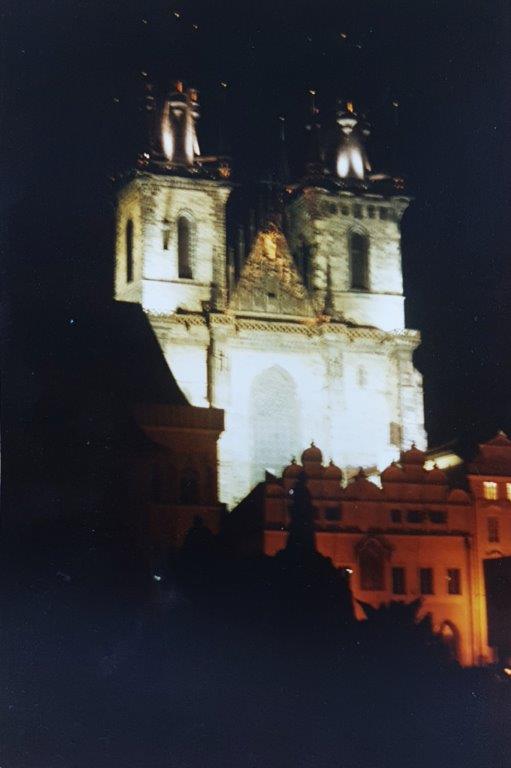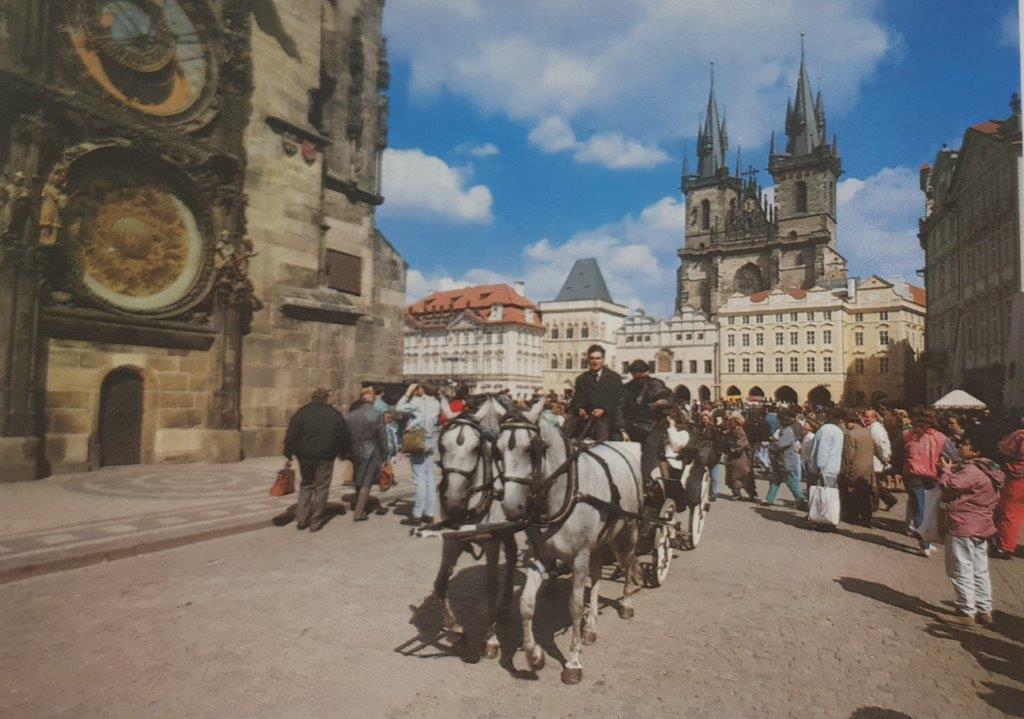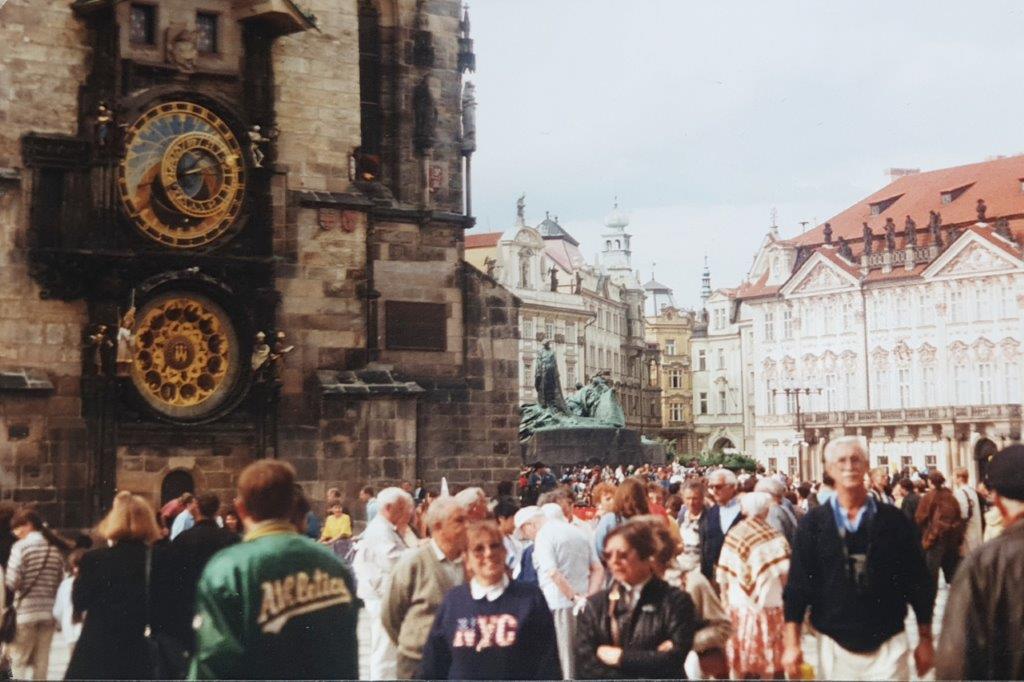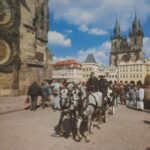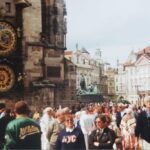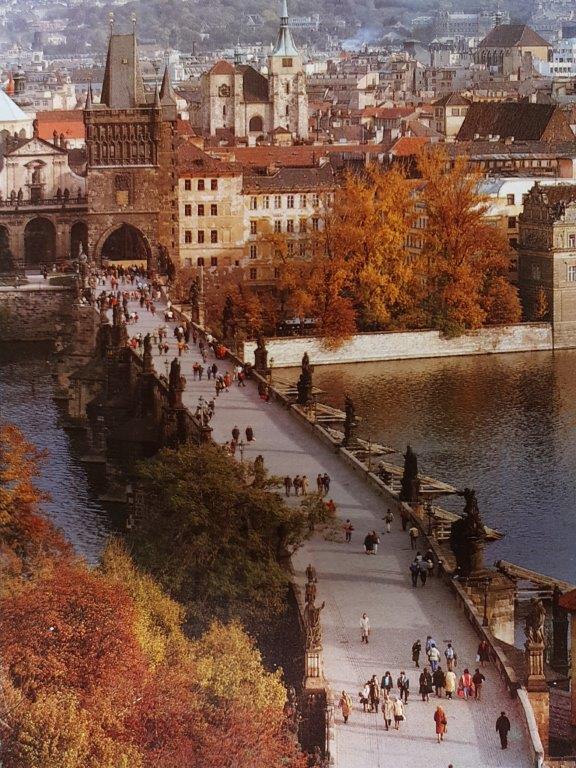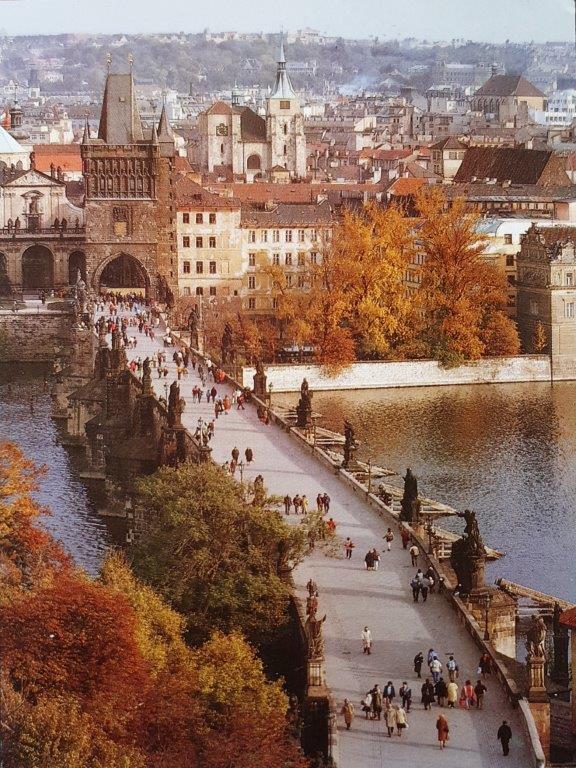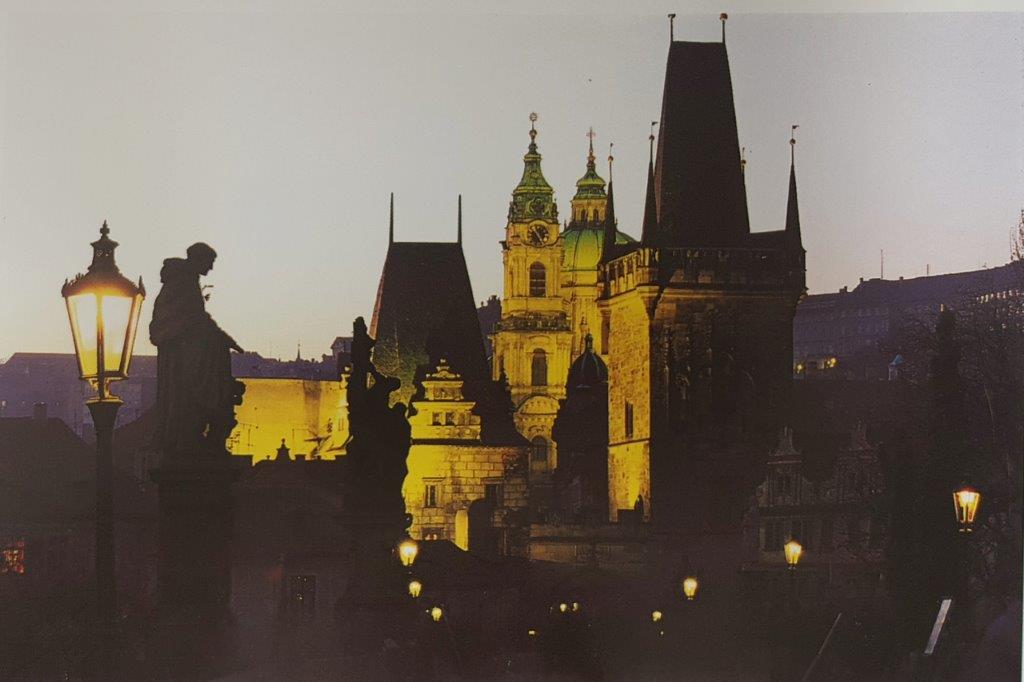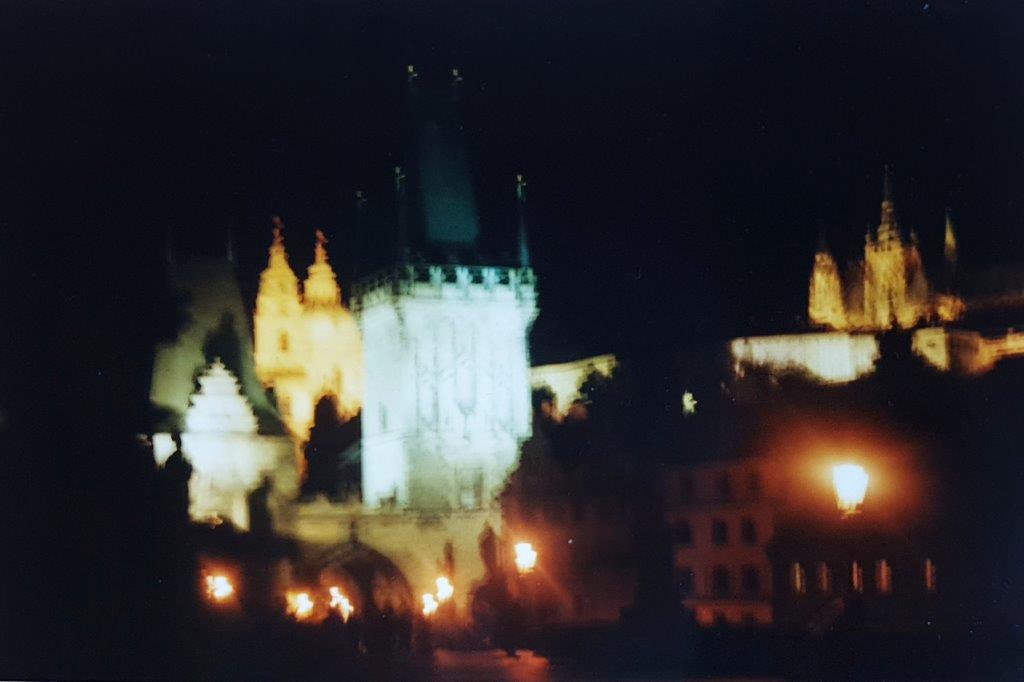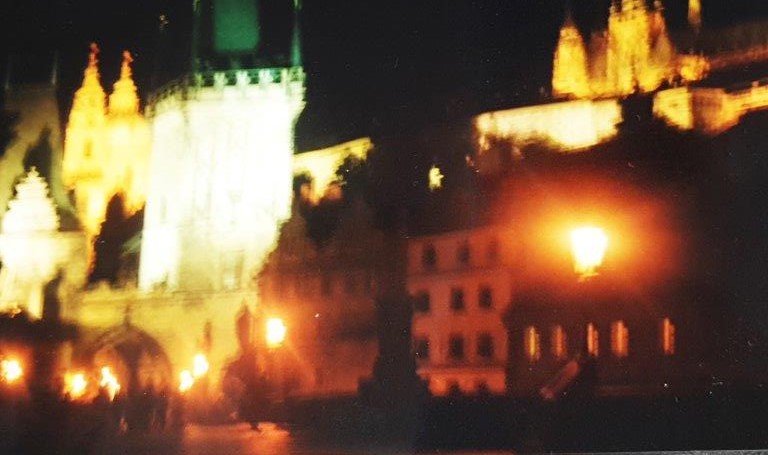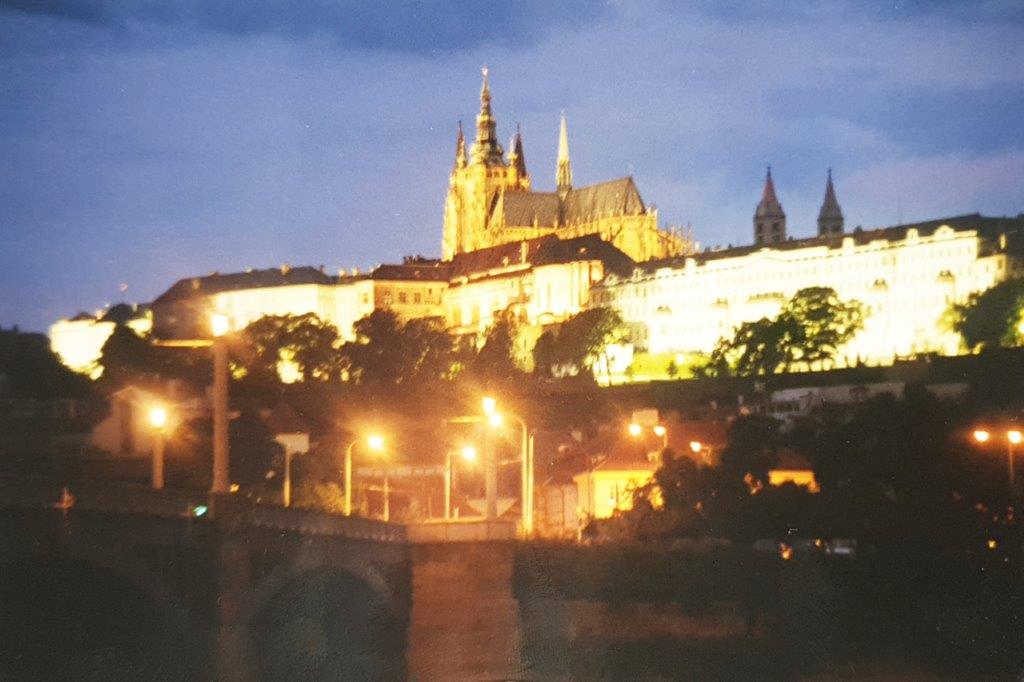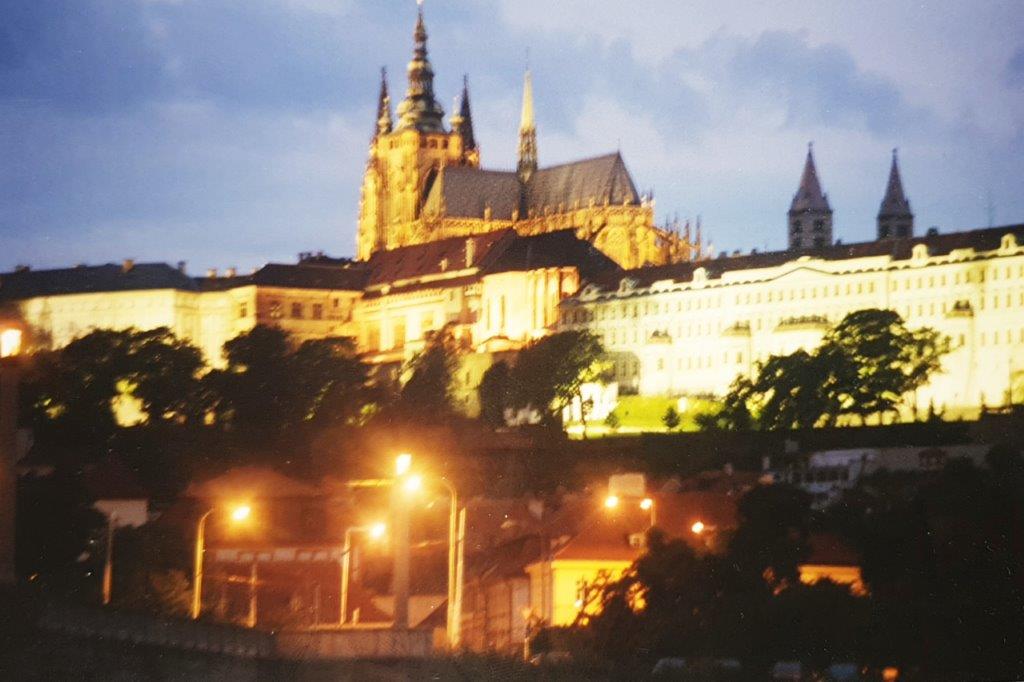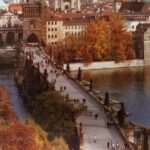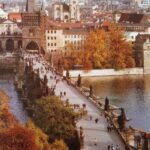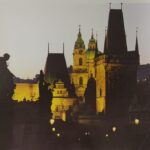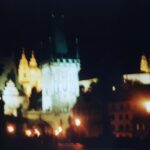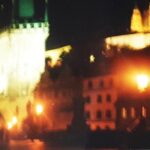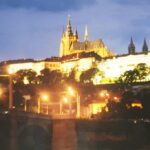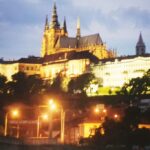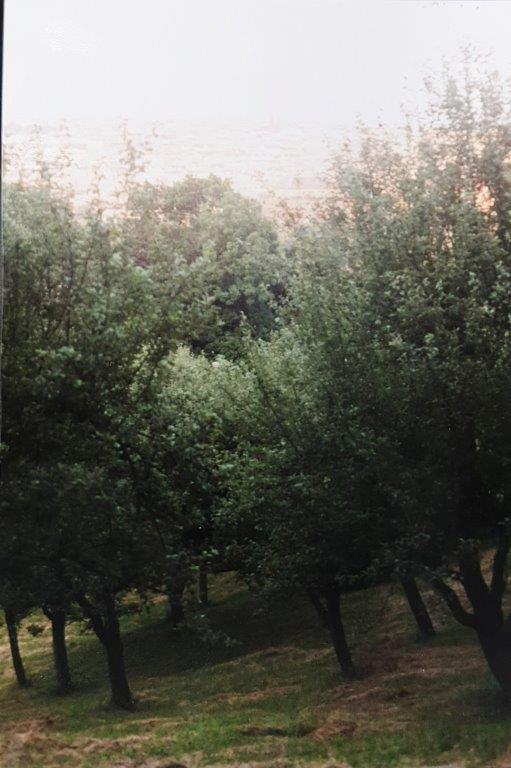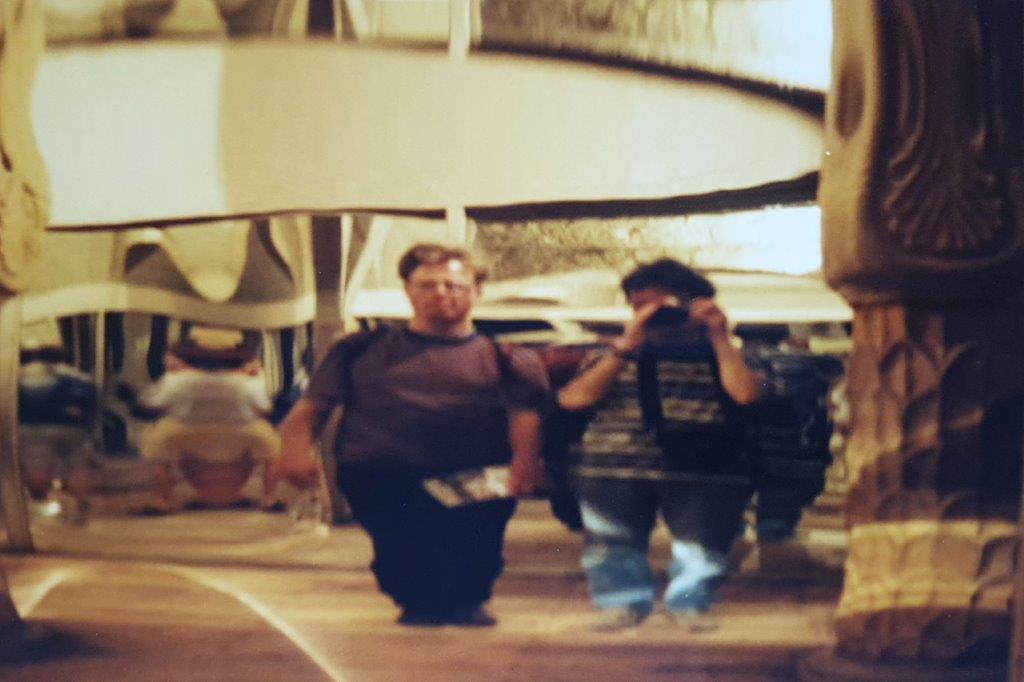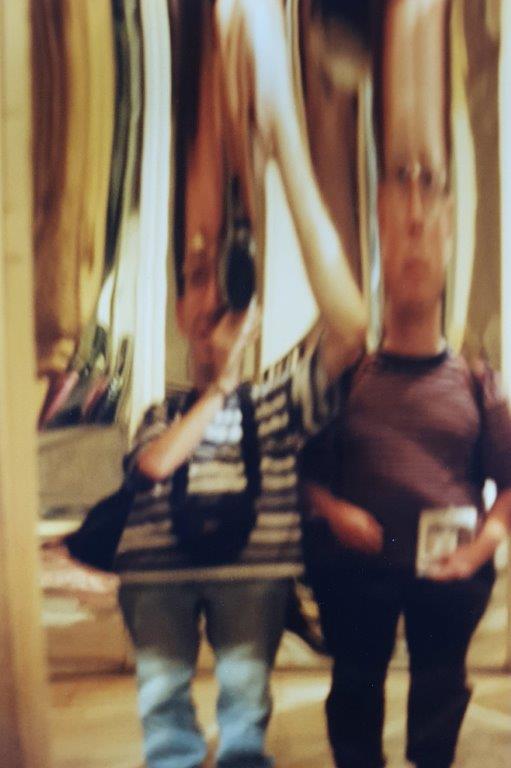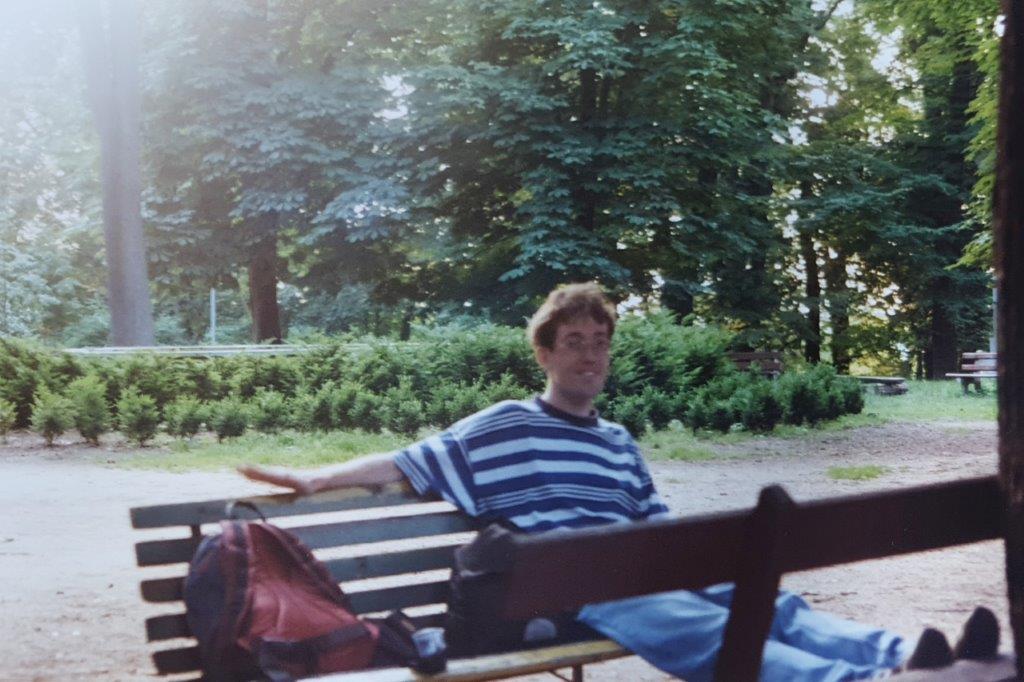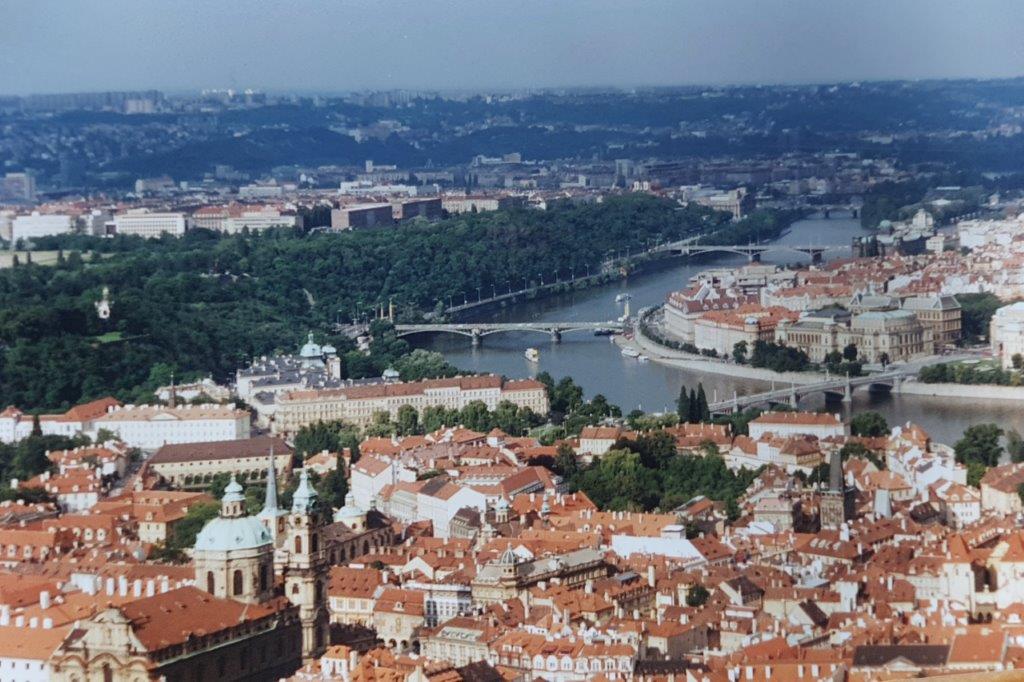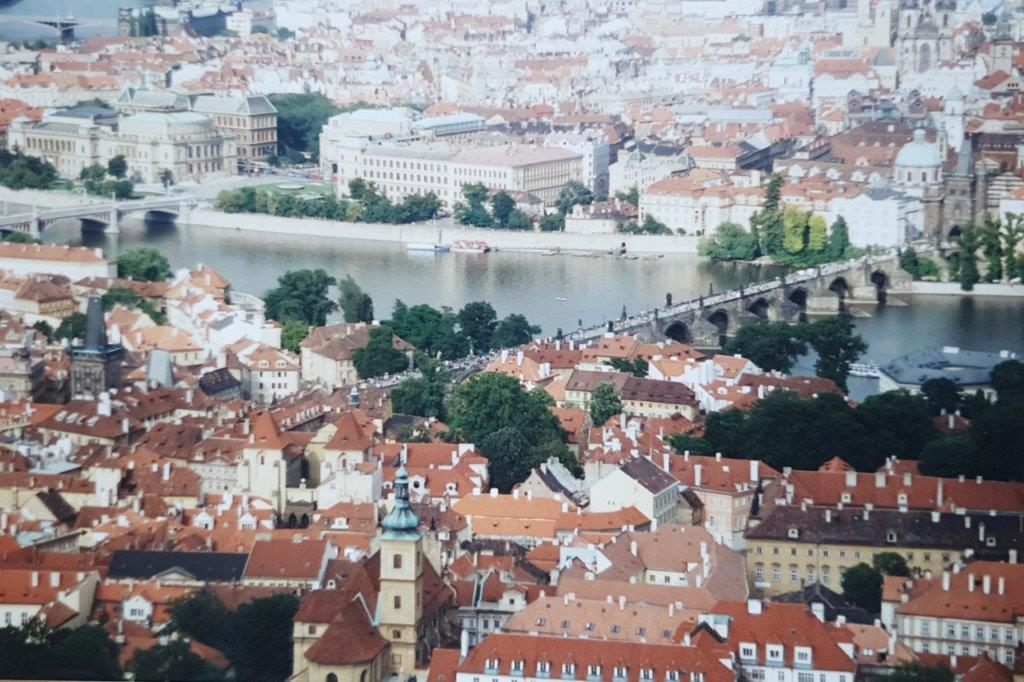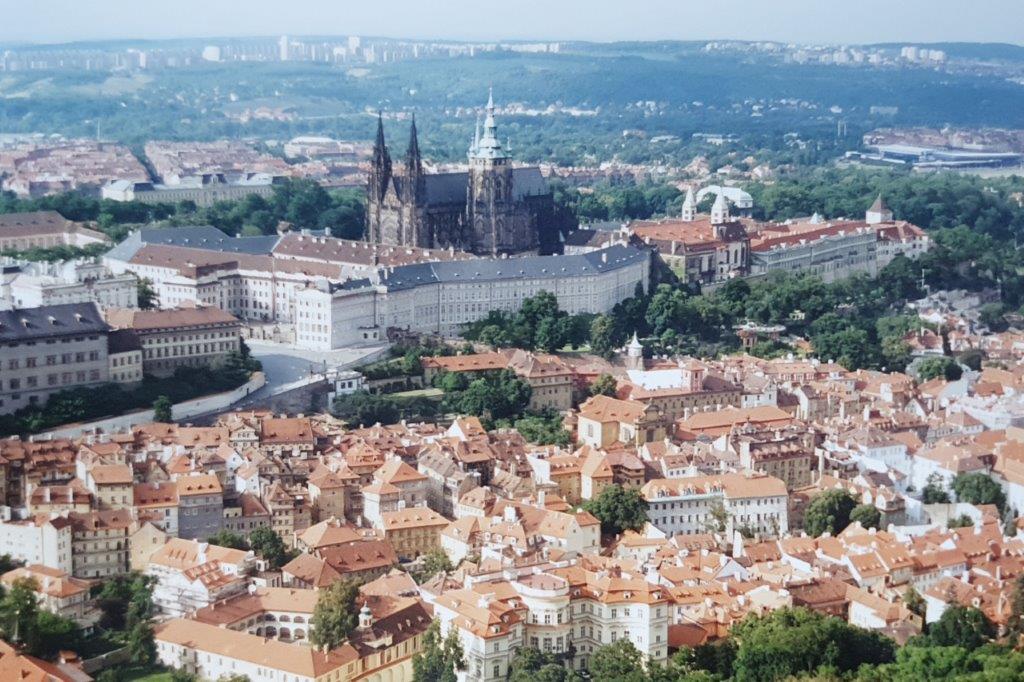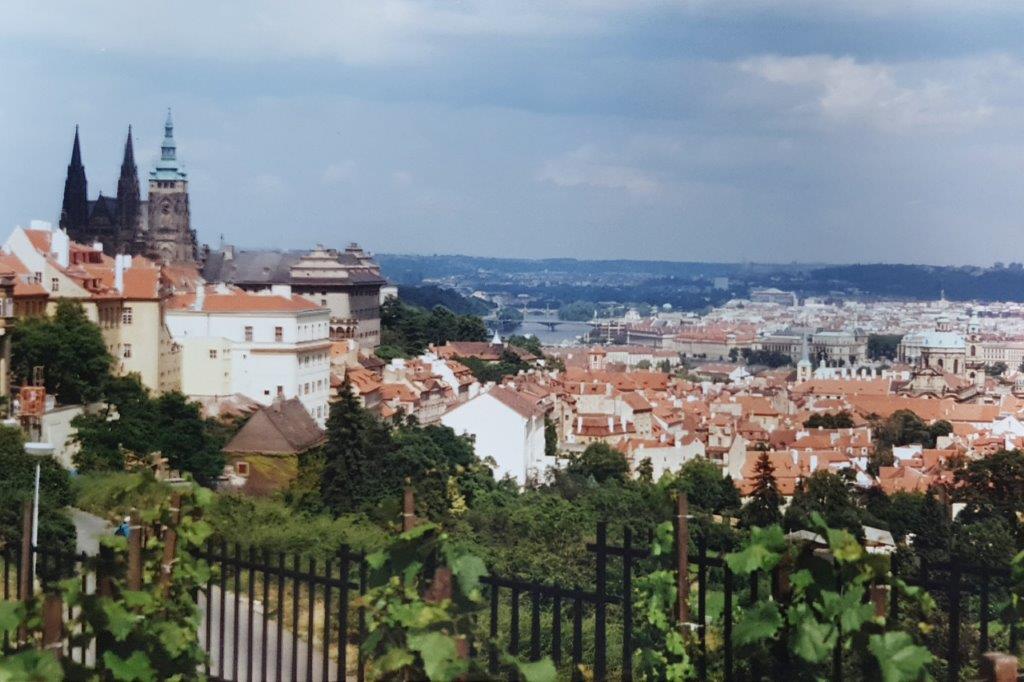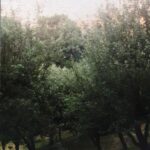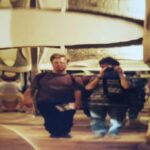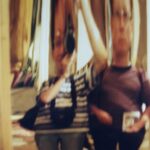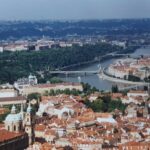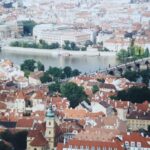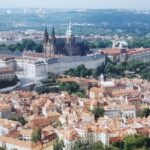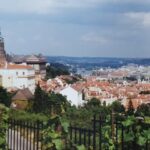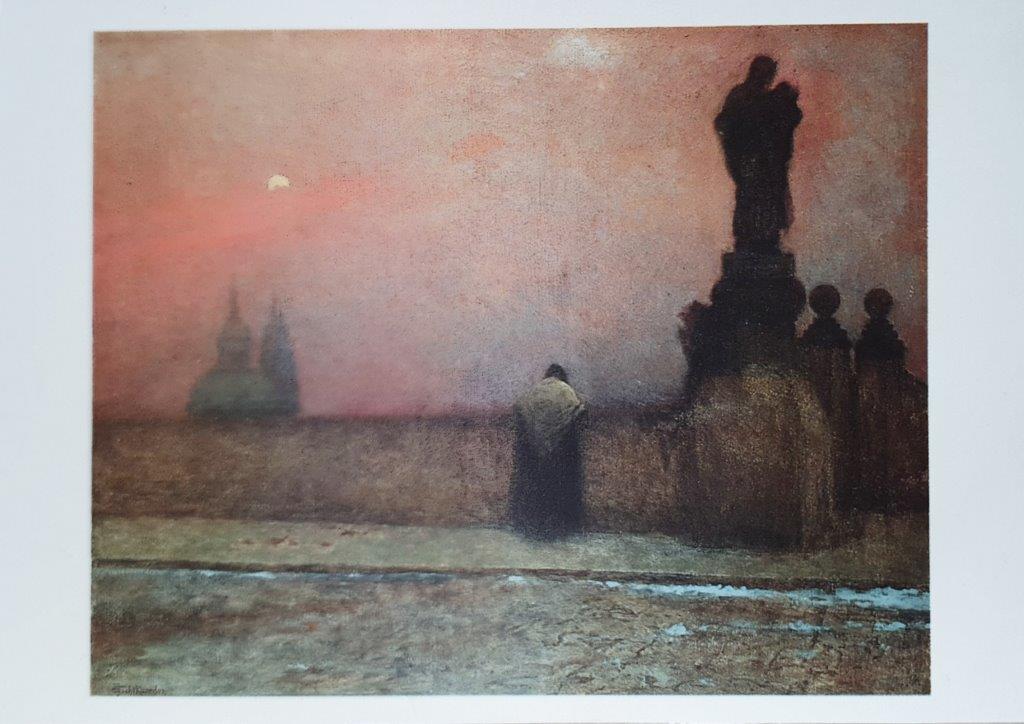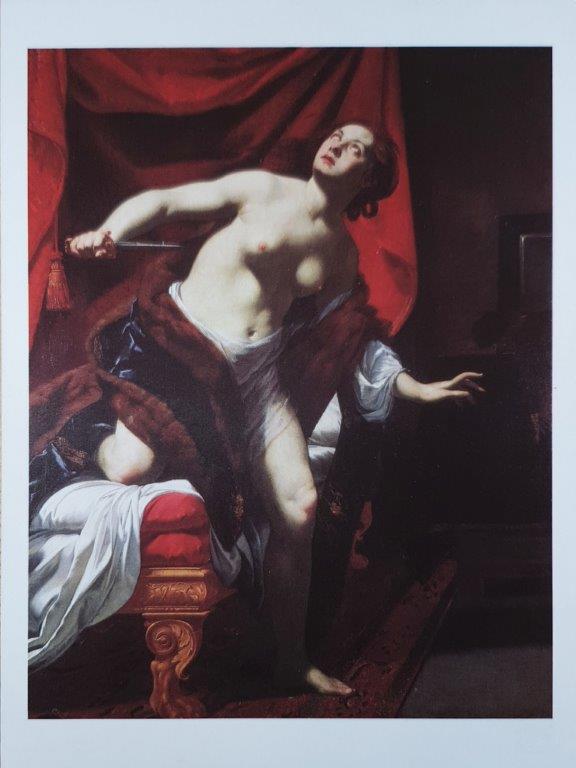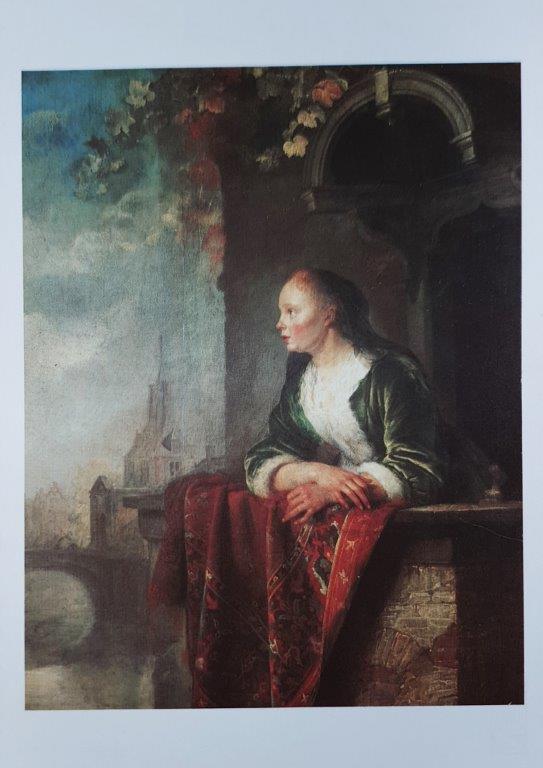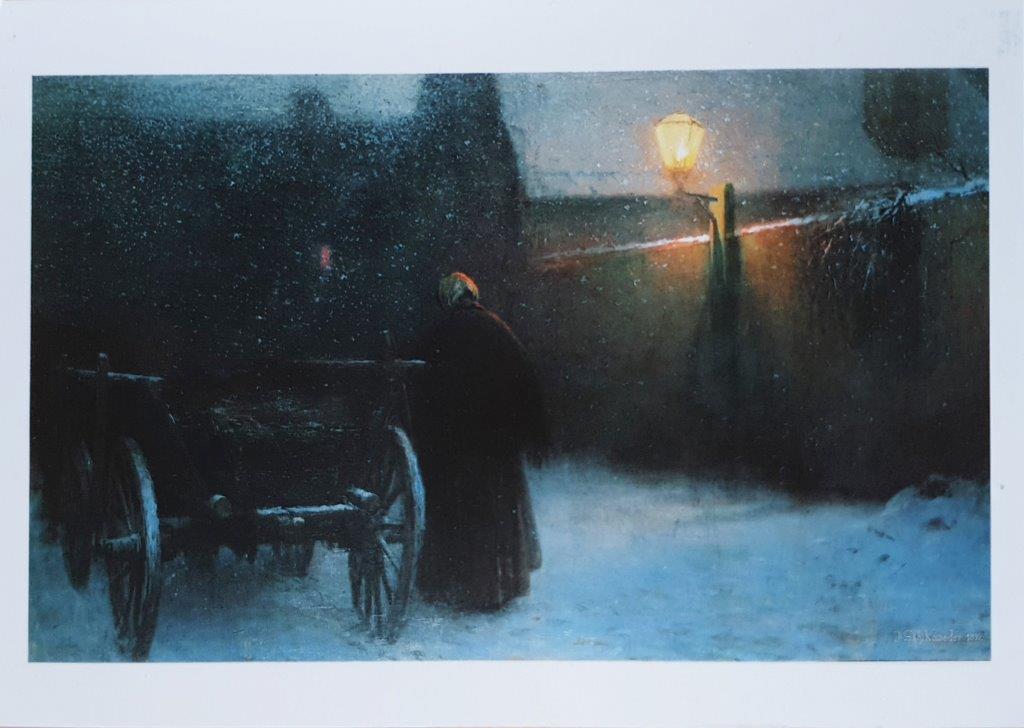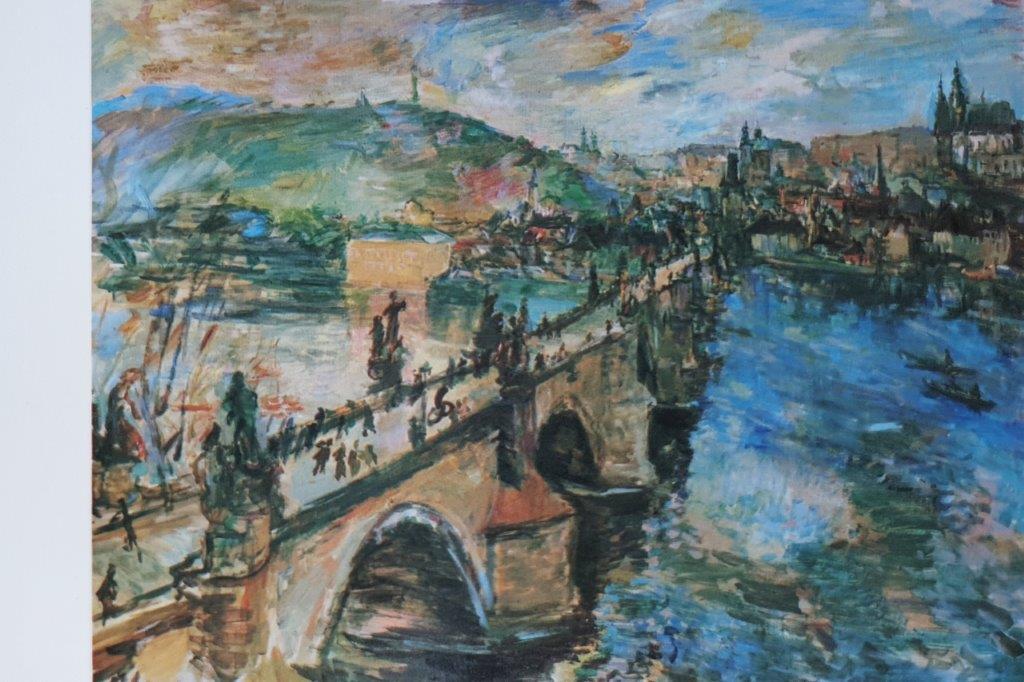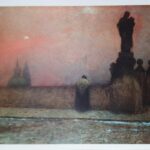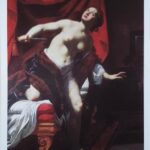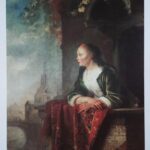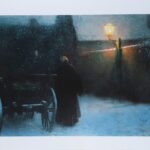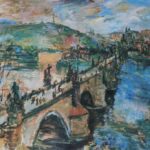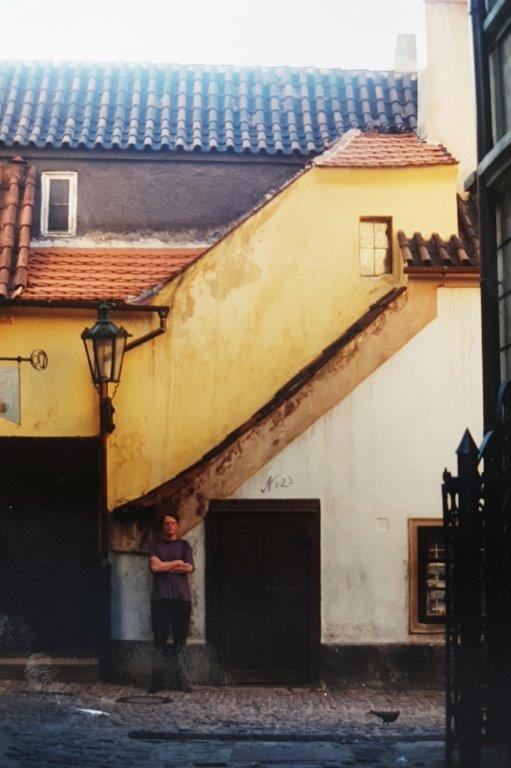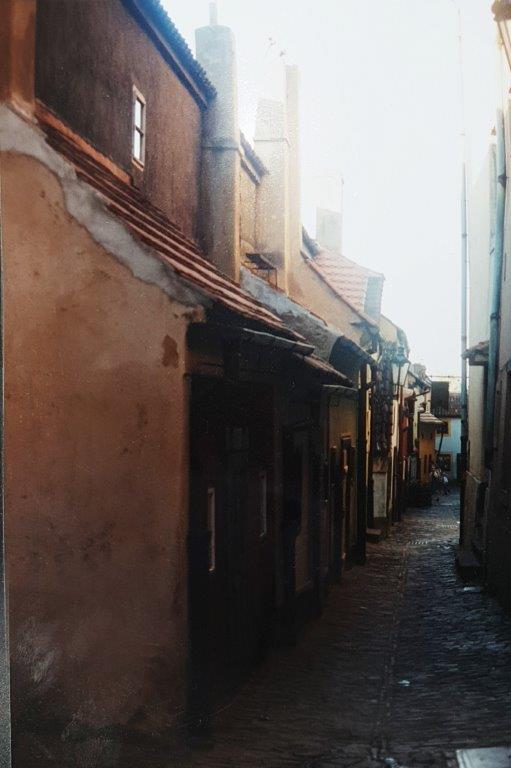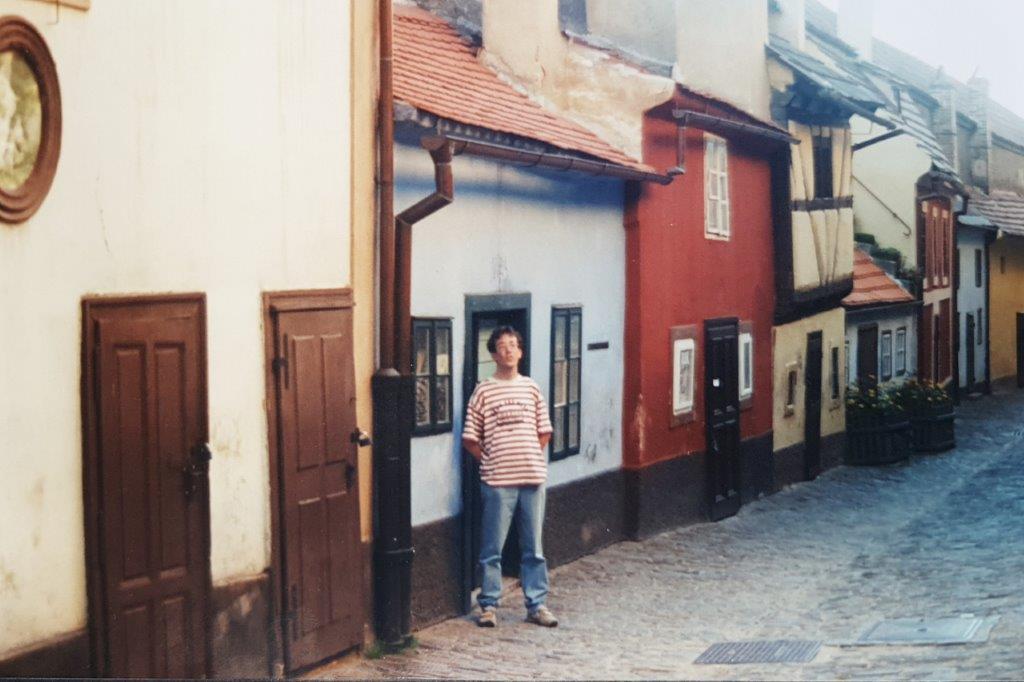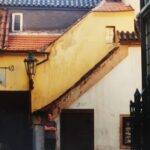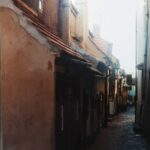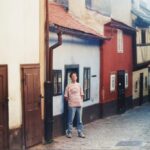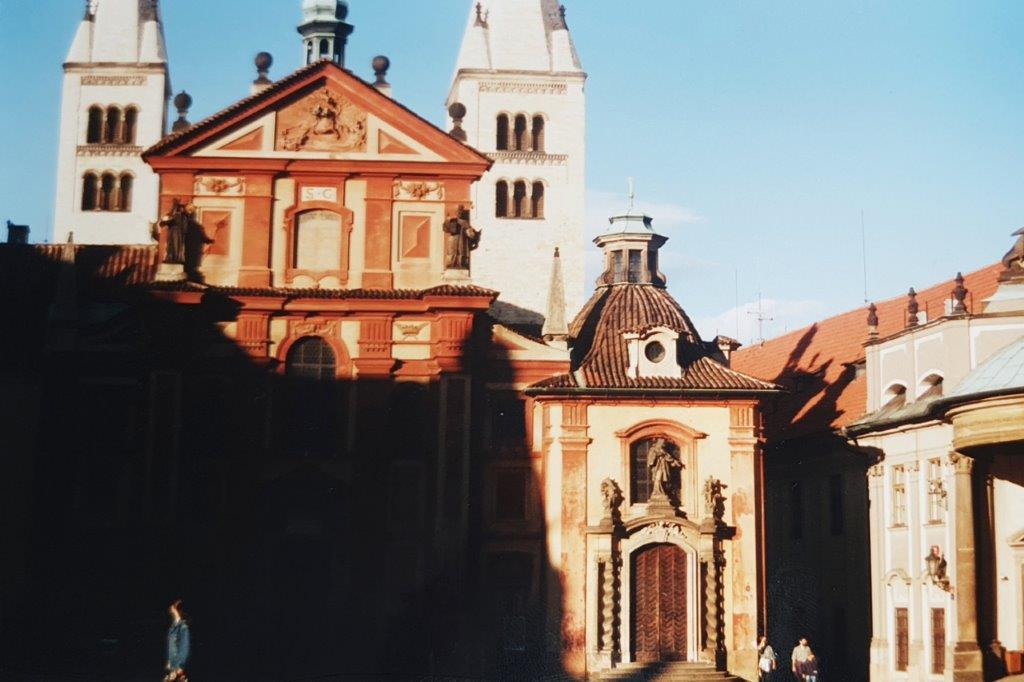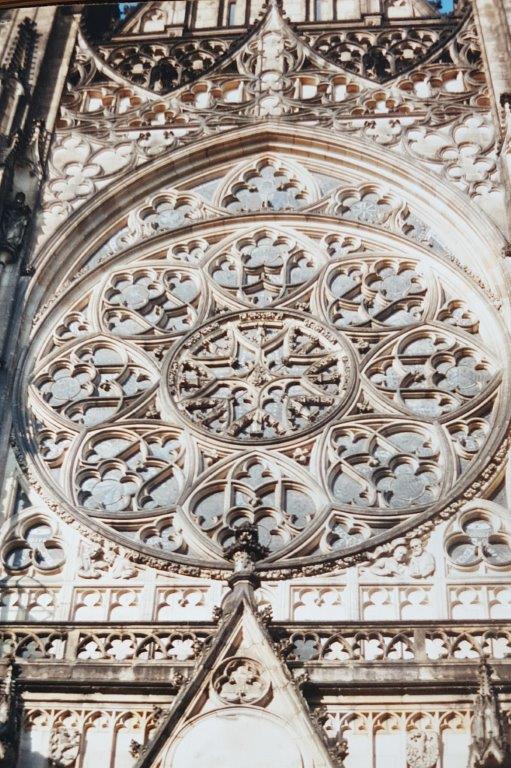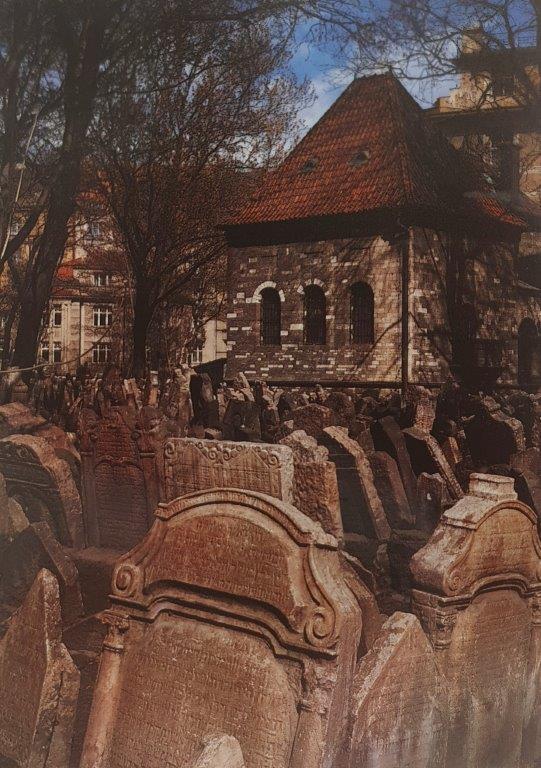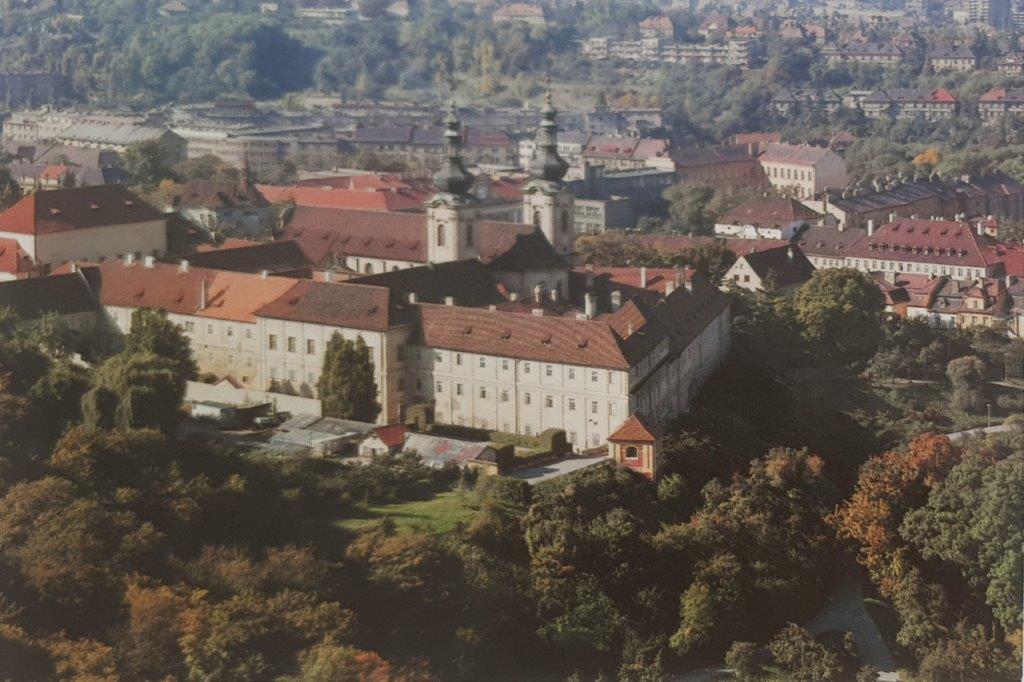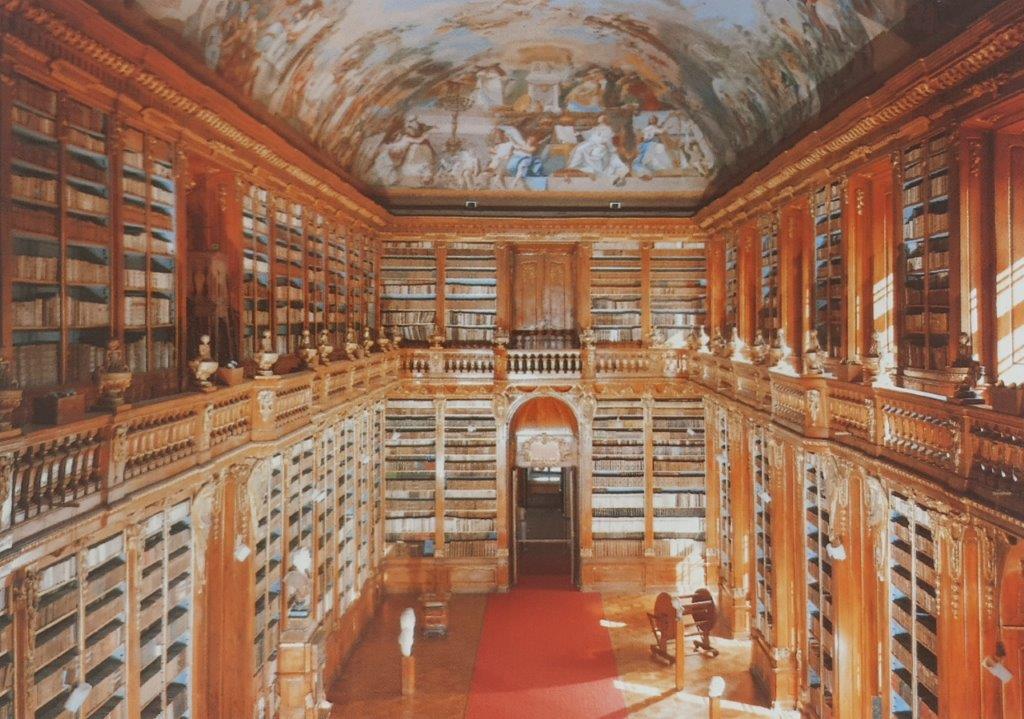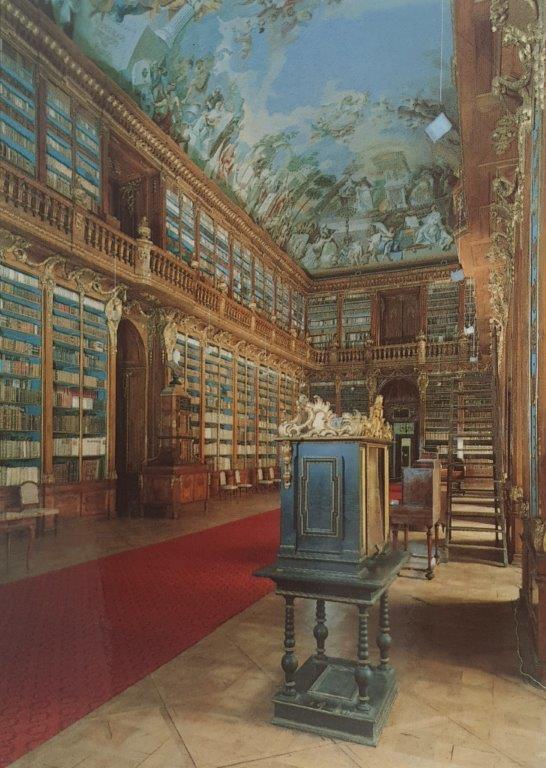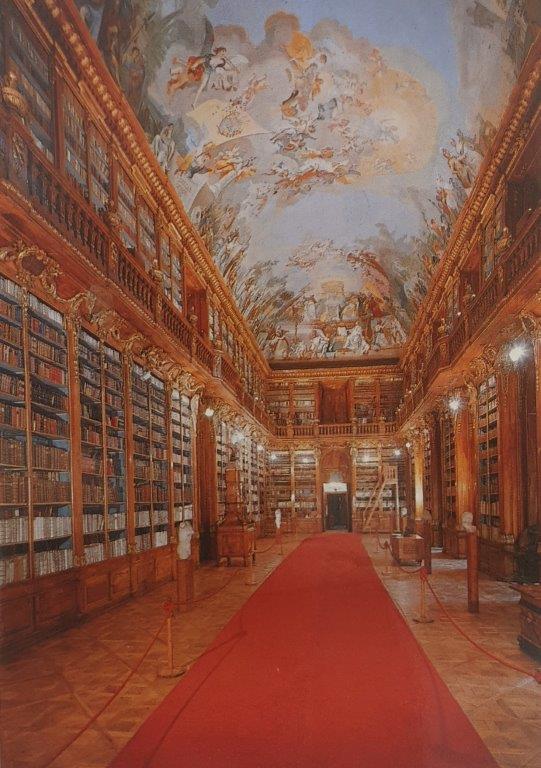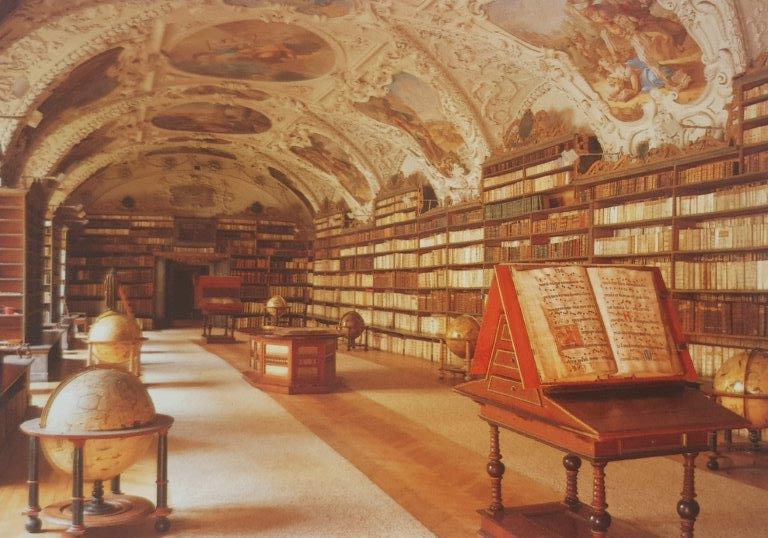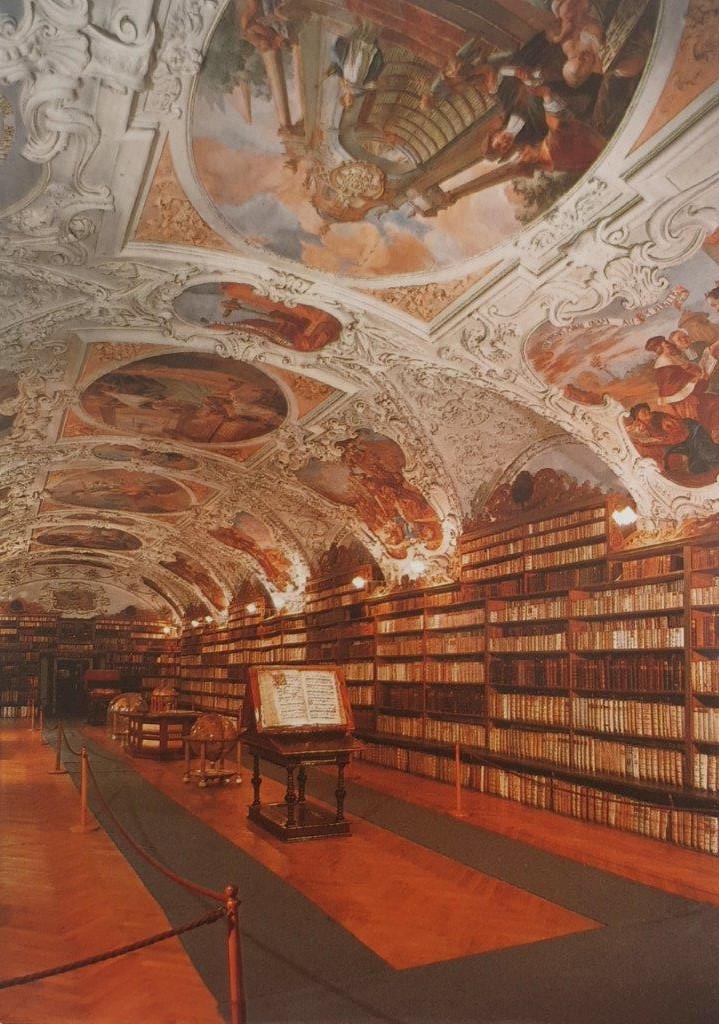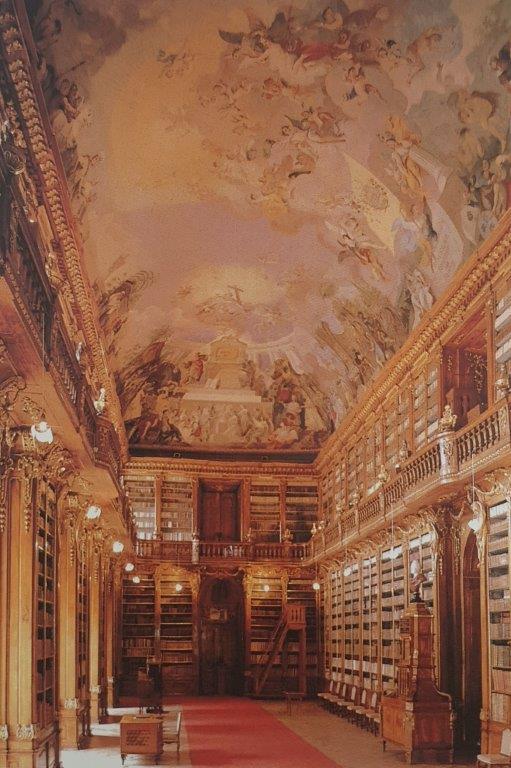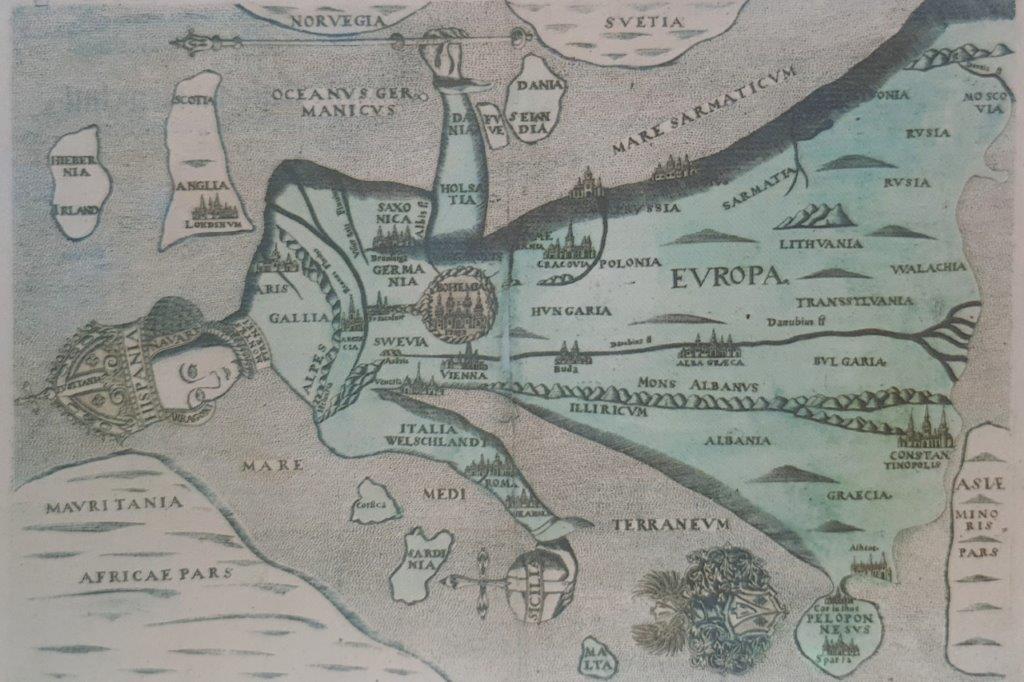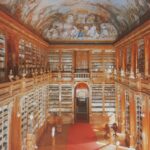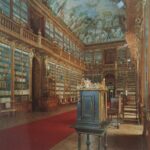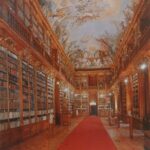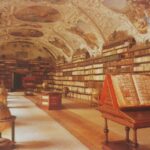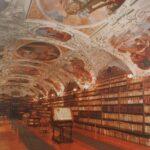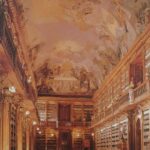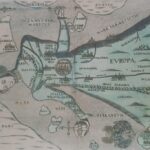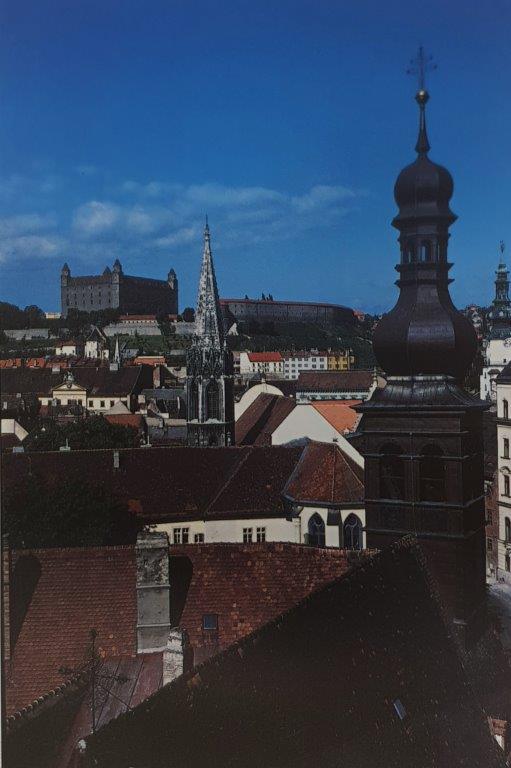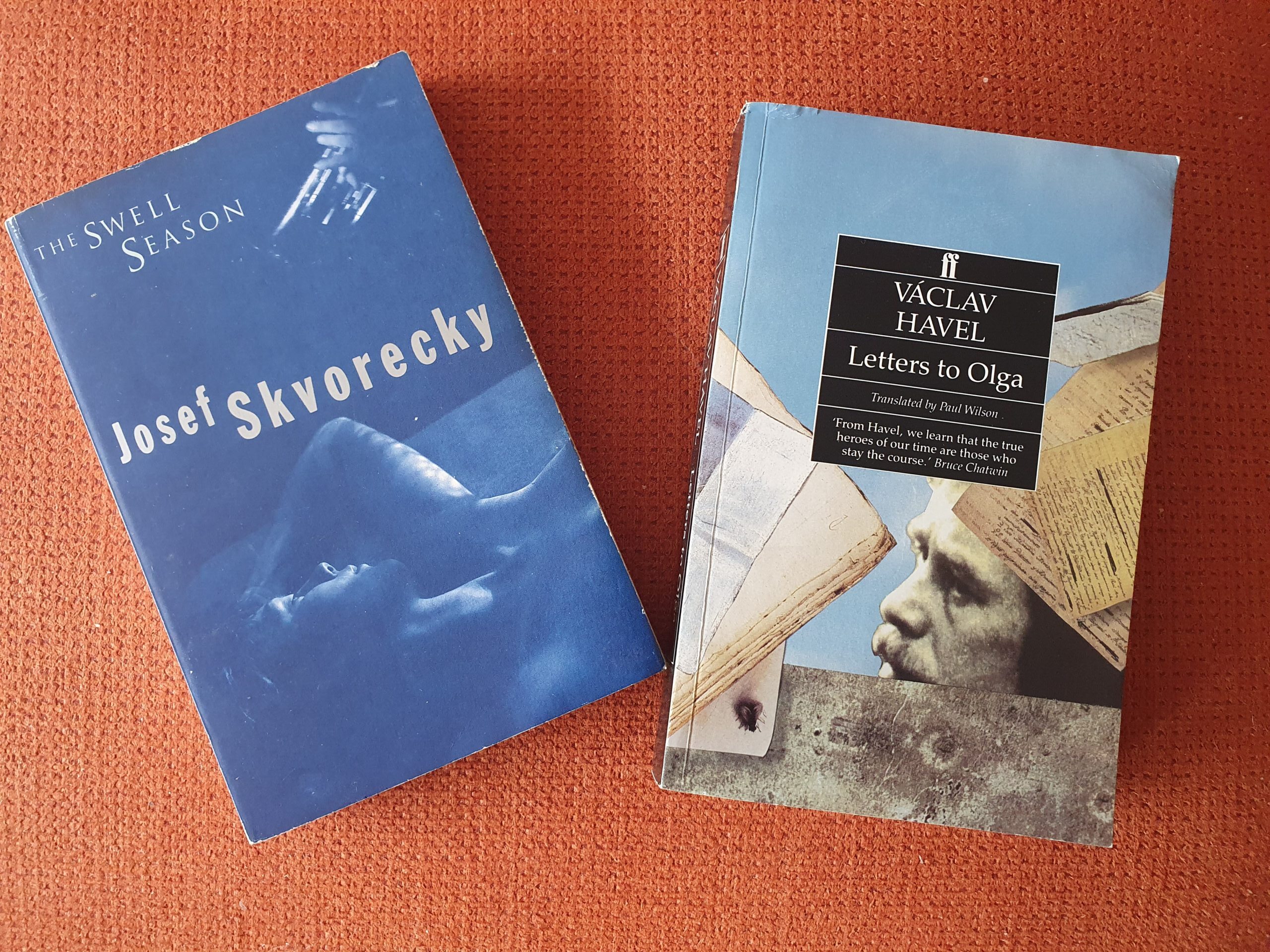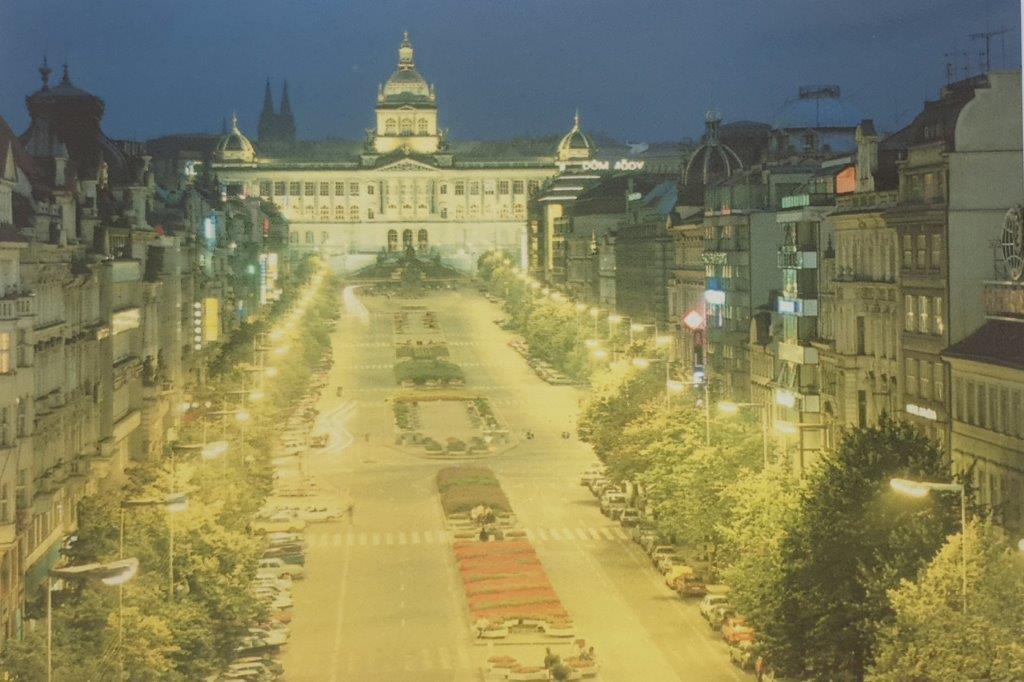5. Prague
After arriving in Prague sometime in the afternoon, De Wandelgek found a campsite on the outskirts of town, pitched the tent and started writing postcards to send from the campsite. This was followed by a pleasant evening in front of the tent. The neighbors were 2 Polish guys (Radoslav and Andrew or Andy as he nicknamed himself) and on the other side was the tent of a French girl who was backpacking. We had put a folding table between our tents and then the bottles of pivo quickly appeared. The conversations started in German and English we could understand each other well and we talked about football and music from U2 to The Doors and travelling on the TransSib (a seemingly far away goal back then, which The Wandelgek realised in 2019)…
Prague was a very pleasant town. First of all there was almost no rain so the decission to leave Slovakia’s Tatra mountains was a good one. From the campsite to the city center could be done by bus and the bus was available until deep into the night.
The city is still the most beautiful city The Wandelgek has ever been too. The architecture is phenomenal, but added to that is the display of that architecture against the surrounding hills.
In Prague there were so many…
Prague
Prague (Czech: Praha); German: Prag; Dutch: Praag; Latin: Praga) is the capital and largest city in the Czech Republic, the 13th largest city in the European Union and the historical capital of Bohemia. Situated on the Vltava river, Prague is home to about 1.3 million people, while its metropolitan area is estimated to have a population of 2.7 million. The city has a temperate oceanic climate, with relatively warm summers and chilly winters.
Prague is a political, cultural, and economic centre of central Europe complete with a rich history. Founded during the Romanesque and flourishing by the Gothic, Renaissance and Baroque eras, Prague was the capital of the Kingdom of Bohemia and the main residence of several Holy Roman Emperors, most notably of Charles IV (r. 1346–1378). It was an important city to the Habsburg Monarchy and its Austro-Hungarian Empire. The city played major roles in the Bohemian and Protestant Reformation, the Thirty Years’ War and in 20th-century history as the capital of Czechoslovakia between the World Wars and the post-war Communist era. Prague is home to a number of well-known cultural attractions, many of which survived the violence and destruction of 20th-century Europe. Main attractions include Prague Castle, Charles Bridge, Old Town Square with the Prague astronomical clock, the Jewish Quarter, Petřín hill and Vyšehrad. Since 1992, the extensive historic centre of Prague has been included in the UNESCO list of World Heritage Sites.
The city has more than ten major museums, along with numerous theatres, galleries, cinemas, and other historical exhibits. An extensive modern public transportation system connects the city. It is home to a wide range of public and private schools, including Charles University in Prague, the oldest university in Central Europe.
Prague is classified as an “Alpha-” global city according to GaWC studies and ranked sixth in the Tripadvisor world list of best destinations in 2016. In 2019, the city was ranked as 69th most liveable city in the world by Mercer. In the same year, the PICSA Index ranked the city as 13th most liveable city in the world. Its rich history makes it a popular tourist destination and as of 2017, the city receives more than 8.5 million international visitors annually. In 2017 Prague was listed as the fifth most visited European city after London, Paris, Rome, and Istanbul.
Prague and the Vltava river
Between 1874 and 1879, Czech composer Bedřich Smetana composed a set of six symphonic poems and named them: Ma Vlast (My fatherland). The sixth and most famous piece he named Vltava (and in Dutch this is called: De Moldau).
The composition describes the course of the Vltava, starting from the two small springs, the Cold and Warm Vltava, to the unification of both streams into a single current, the course of the Vltava through woods and meadows, through landscapes where a farmer’s wedding is celebrated, the round dance of the mermaids in the night’s moonshine: on the nearby rocks loom proud castles, palaces and ruins aloft. The Vltava swirls into the St John’s Rapids; then it widens and flows toward Prague, past the Vyšehrad, and then majestically vanishes into the distance, ending at the Labe (or Elbe, in German).
The Vltava (Czech: Vl̩tava; German/Dutch: Moldau) is the longest river within the Czech Republic, running southeast along the Bohemian Forest and then north across Bohemia, through Český Krumlov, České Budějovice and Prague, and finally merging with the Elbe at Mělník. It is commonly referred to as the “Czech national river”.
Both the Czech name Vltava and the German name Moldau are believed to originate from the old Germanic words *wilt ahwa (“wild water”; compare Latin aqua). In the Annales Fuldenses (872 AD) it is called Fuldaha; from 1113 AD it is attested as Wultha. In the Chronica Boemorum (1125 AD) it is attested for the first time in its Bohemian form, Wlitaua.
As described above, the real Vltava flows steadily through the majestic, monumental city of Prague, underneath its ancient bridges…
The Wandelgek visited Prague as part of a combined journey through Slovakia and Czechia, where the Slovakian part should have been a walking trail through the High Tatra mountains, which due to very bad weather conditions, never really took off. Alternatively the Wandelgek decided to visit Prague, to escape the heavy rainfall and thunderstorms in the mountains. That would prove to be a good choice because weather conditions stayed bad in the Tatras and in Prague they were much friendlier. Thus The Wandelgek discovered Prague and up til now this is still his most favorite city ever. It surpasses all other cities he visited in beauty, even cities like Budapest, Vienna, Paris, London, Firenze, Verona, Padua, Venice, Istanbul, Stockholm, Copenhagen, Amsterda, Brussels, Gent, Bruges, Saint Petersburg, Moscow, Samarkand, Buchara, Kathmandu and Stone Town. A lot of travellers he spoke in subsequent years agree, although a lot also talk of Rome surpassing Pragues beauty, but that eternal city is still on his bucketlist.
This blogpost should have been written right after the Slovakian posts, but the analogue pictures got lost and I rediscovered them only recently.
Beneath is a recollection of sites and some stories of events that occured way back in 1996.
Staroměstské Náměstï (The old square)
Old Town Square (Czech: Staroměstské náměstí ) is a historic square in the Old Town quarter of Prague, the capital of the Czech Republic. It is located between Wenceslas Square and Charles Bridge.
The square features buildings belonging to various architectural styles, including the Gothic Church of Our Lady before Týn, which has been the main church of this part of the city since the 14th century. Its characteristic towers are 80 m high. The Baroque St. Nicholas Church is another church located in the square.
Prague Orloj is a medieval astronomical clock mounted on the Old Town Hall. The clock was first installed in 1410, making it the third-oldest astronomical clock in the world and the oldest one still in operation. The tower of the Old Town Hall is open to the public and offers panoramic views of the Old Town.
An art museum of the Czech National Gallery is located in the Kinský Palace.
Statues and memorials
The square’s centre is home to a statue of religious reformer Jan Hus, who was burned at the stake in Konstanz for his beliefs. This led to the Hussite Wars. The statue known as the Jan Hus Memorial was erected on 6 July 1915 to mark the 500th anniversary of his death.
In front of the Old Town Hall, there is also a memorial to the “martyrs” (including Jan Jesenius and Maxmilián Hošťálek) beheaded on that spot during the Old Town Square execution by Habsburgs, after the Battle of White Mountain. Twenty-seven crosses mark the pavement in their honour. The crosses were installed during the repairs of the Old Town Hall after the WW2, while a nearby plaque which lists the names of all 27 victims dates from 1911. Orthodox Czechs do not trample these crosses out of respect.
On 3 November 1918, a Marian Column that had been erected in the square shortly after the Thirty Years’ War was demolished in celebration of independence from the Habsburg empire. The column was re-erected in 2020.
The astronomical clock
The Prague astronomical clock at the Old Town Hall is one of the most famous astronomical clocks. The central section was completed in 1410, the calendar dial was added in 1490. The clock was renovated after damage during World War II, and in 1979. On the hour, Death strikes the time, and the twelve apostles appear at the doors above the clock.
The pics beneath show the astronomical clock:
Karlův Most (Charles Bridge)
Near the Old Square is The Charles Bridge, which is the most beautiful bridge of Prague.
Charles Bridge (Czech: Karlův most) is a medieval stone arch bridge that crosses the Vltava (Moldau) river in Prague, Czech Republic. Its construction started in 1357 under the auspices of King Charles IV, and finished in the early 15th century. The bridge replaced the old Judith Bridge built 1158–1172 that had been badly damaged by a flood in 1342. This new bridge was originally called Stone Bridge (Kamenný most) or Prague Bridge (Pražský most), but has been referred to as “Charles Bridge” since 1870.
As the only means of crossing the river Vltava until 1841, Charles Bridge was the most important connection between Prague Castle and the city’s Old Town and adjacent areas. This land connection made Prague important as a trade route between Eastern and Western Europe.
A UNESCO World Heritage site, the bridge is 516 metres (1,693 ft) long and nearly 10 metres (33 ft) wide, following the example of the Stone Bridge in Regensburg, it was built as a bow bridge with 16 arches shielded by ice guards. It is protected by three bridge towers, two on the Lesser Quarter side (including the Malá Strana Bridge Tower) and one on the Old Town side, the Old Town Bridge Tower. The bridge is decorated by a continuous alley of 30 statues and statuaries, most of them baroque-style, originally erected around 1700, but now all have been replaced by replicas.
The bridge is currently undergoing a twenty-year process of structural inspections, restoration, and repairs. The process started in late 2019, and is expected to cost 45-60 Million Czech Koruna (USD 1.9-2.6 Million).
Charles Bridge is foot bridge. In summer and specially on hot summernights young people gather here to see performances of street theater and music performances. The Wandelgek sat there, on the pavement, drinking a cola for several evenings, listening to musicians playing covers of The Smashing Pumpkins, The Violent Femmes, The Velvet Underground. It was summer and the evenings stayed warm.
On one of those evenings, men in black appeared. They looked like Gorillas, wore dark sunglasses and had electronic earphones. They were clearing a wide path accross the bridge.Then two people and some entourage followed. A man and a woman, walking over the bridge, coming from the Prague Castle. When they were nearer, The Wandelgek saw that it was President Vaclav Havel and the Minister of Foreign Affairs of the US, Madeleine Albright.
Wallenstein Palace and Garden
A green oasis in this town is the Wallenstein Garden, which can not be seen from the road.
Music performances in town
Besides the differentmusic performances on Karls Bridge, The Wandelgek also visited two very different other shows. One was in a church near Wallenstein Garden, where he visited an organ performance of Ave Maria’s. Of course the two most famous Ave Maria’s, by Gounod and by Schubert were played too.
Ome of the evenings in Prague, The Wandelgek visited an Irish Pub where a live show by a Beatles coverband wearing Sergeant Pepper’s Lonely Hearts Club Band uniforms was performed. The pub was crowded with Irish and English guests and the band was on a roll.
Petřínpark
A must-see is the Petřínpark on top of Petřín Hill. The Wandelgek walked up and down, but there’s a funicular railway going up and down too. There’s a panorama tower, a mirror palace with a mirror maze and laughing mirrors and a stroll through the beautiful park brings you to its edge from where you’ll have amazing views over Prague, the royal castle and de Vltava river and its many bridges…
Petřín is a hill in the centre of Prague, Czech Republic. It rises 327 m above sea level and some 130 m above the left bank of the Vltava River. The hill, almost entirely covered with parks, is a favorite recreational area for the inhabitants of Prague. The hill (in German known as Laurenziberg) is featured prominently in Franz Kafka’s early short story “Description of a Struggle” and briefly in Milan Kundera’s novel The Unbearable Lightness of Being, which is one of The Wandelgek’s favorite books and movies as well.
The chronicler Cosmas describes Petřín as a very rocky place, the hill is allegedly called Petřín because of the large number of rocks (Latin: petra). Since ancient times, stones were dug and were used to construct buildings in Prague. Medieval defence wall, the Hunger Wall was built on Petřín Hill during 1360 – 1362, by the order of Czech King Charles IV. The Petřín Lookout Tower, which strongly resembles the Eiffel Tower, was built atop a hill in 1891. Other sights include the Rose Garden, Mirror Maze, Cathedral of Saint Lawrence, and St Michael Church.
Klášter sv. Anežky (Saint Agnes Monastery)
This monastery contains a museum with beautiful paintings by mostly Czech artists. Some examples below:
In Mala Strana is a wall which is decorated with John Lennon memorial paintings. I specificly liked this one which is almost like a shrine. The lit candle does the rest…
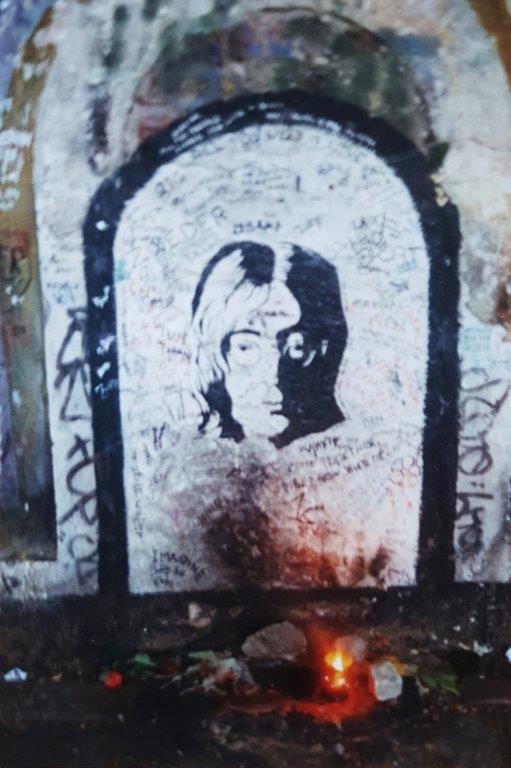
Prague Castle
Prague Castle (Czech: Pražský hrad) is a castle complex in Prague, Czech Republic, built in the 9th century. It is the official office of the President of the Czech Republic. The castle was a seat of power for kings of Bohemia, Holy Roman emperors, and presidents of Czechoslovakia. The Bohemian Crown Jewels are kept within a hidden room inside it.
According to the Guinness Book of Records, Prague Castle is the largest ancient castle in the world, occupying an area of almost 70,000 square metres (750,000 square feet), at about 570 metres (1,870 feet) in length and an average of about 130 metres (430 feet) wide. The castle is among the most visited tourist attractions in Prague attracting over 1.8 million visitors annually.
Golden Lane
Golden Lane (Czech: Zlatá ulička) is a street situated in Prague Castle, Czech Republic. Originally built in the 16th century to house Rudolf II’s castle guards, it takes its name from the goldsmiths that lived there in the 17th century. Although the lane was temporarily called the Street of Alchemists or Alchemists’ Alley, alchemists have never worked or lived there.
Saint Joris Monastery and Basilik
St. George’s Basilica is the oldest surviving church building within Prague Castle, Prague, Czech Republic. The basilica was founded by Vratislaus I of Bohemia in 920. It is dedicated to Saint George. Primarily Romanesque in style (which deviates from the commonly found baroque and rococo style of other Prague churches), it is part of the collection of buildings that comprise the castle, the political capital of the nation, and the spiritual center of the Czech state.
Current usage
The basilica is part of the Prague castle complex of buildings. The castle was the political capital of the nation and the basilica was part of its spiritual center.
In 1962, the building was declared a national cultural monument and converted into a concert hall. Between 1969 and 1975, it was converted into an exhibition space. The building now houses the 19th century Bohemian Art Collection of National Gallery in Prague. It also serves as a concert hall.
Royal Palace
The Old Royal Palace (Czech: Starý královský palác) is part of the Prague Castle, Czech Republic. Its history dates back to the 12th century and it is designed in the Gothic and Renaissance styles. Its Vladislav Hall is used for inaugurations, being the most important representative hall in the country. It is also home to a copy of the Czech crown.
Nowadays, the exit from the Vladislav Hall is formed by the Riders’ Staircase, built originally to enable knights to enter the hall on horseback in order to take part in the jousting competitions held in it. The staircase is vaulted with a complicated Late Gothic rib vault.
Saint Vitus Cathedral
Šternberský Palác (Sternberg palace)
The Sternberg Palace (Hradčany) houses the European Art collection of the National Gallery, from Antiquity to the end of the Baroque period.
The Wandelgek visited this collection and below are some of the paintings of the collection:
Starý Zidovský Hřbitov (The Old Jewish Cemetry)
The Old Jewish Cemetery is a Jewish cemetery in Prague, Czech Republic, which is one of the largest of its kind in Europe and one of the most important Jewish historical monuments in Prague. It served its purpose from the first half of 15th century until 1786. Renowned personalities of the local Jewish community were buried here; among them rabbi Jehuda Liva ben Becalel – Maharal (ca. 1526–1609), businessman Mordecai Meisel (1528–1601), historian David Gans (ca. 1541–1613) and rabbi David Oppenheim (1664–1736). Today the cemetery is administered by the Jewish Museum in Prague.
The cemetery is mentioned in Umberto Eco’s The Prague Cemetery, the novel which was named after it.
The n The Wandelgek visited the
Spanish Synagogue
The Spanish Synagogue is the newest synagogue in the area of the so-called Jewish Town, yet paradoxically, it was built at the place of the presumably oldest synagogue, Old School (also known as Altshul). The synagogue is built in Moorish Revival Style. Only a little park with a modern statue of famous Prague writer Franz Kafka (by Jaroslav Róna) lies between it and the church of Holy Spirit. Today, the Spanish Synagogue is administered by the Jewish Museum in Prague.
Strahov monastery
Strahov Monastery (Czech: Strahovský klášter) is a Premonstratensian abbey founded in 1143 by Jindřich Zdík, Bishop John of Prague, and Vladislaus II, Duke of Bohemia. It is located in Strahov, Prague, Czech Republic.
Founding of a monastery
After his pilgrimage to the Holy Land in 1138, the bishop of Olomouc, Jindřich Zdík, took hold of the idea of founding a monastery of regular canons in Prague. He had the support of the bishops of Prague and Soběslav I, Duke of Bohemia and—after his death—Vladislav II. After Zdík’s first unsuccessful attempt to found a Czech variant of the canons’ order at the place called Strahov in 1140, an invitation was issued to the Premonstratensians, whose first representatives arrived from Steinfeld in the Rhine valley (now Germany).
The monks began to build their monastery first of wood, with a Romanesque basilica as the center of all spiritual events in Strahov. The building was gradually completed and the construction of the monastery stone buildings continued, in order to replace the provisional wooden living quarters with permanent stone. In 1258, the monastery was heavily damaged by fire and later renewed.
The Theological Hall and the library
In 1670 Jeroným Hirnheim, a philosopher and theologian, became the abbot of Strahov. His greatest work, which has survived to the present day, was the building of a new library in the so-called Theological Hall (Teologický sál), completed in 1679. During the 17th and early 18th centuries, other abbots continued in the reconstruction of the monastery. They also cared for the church, which was repaired and decorated several times during the given period. The monastery experienced other significant building activity, namely after the assaults of French and Bavarian troops in 1742, when Prague was bombarded and seriously damaged. The abbot then organized building efforts anew, in the course of which the church was rebuilt along with the monastery area.
After 1950, the library was incorporated into the Memorial of National Literature. Following events of 1989 the library was, along with the monastery, returned to the Premonstratensians. Within the library, a reading room is also open. The Strahov Library contains over 200,000 volumes, including over 3,000 manuscripts and 1,500 first prints stored in a special depository.
Although The Wandelgek (educated as a Librarian), loved the beautiful library hall, he was devastated by the condition of the books in the archival rooms of the monastery. It showed that, although they had this awesome collection of paper books, they did not have the financial resources to sustain that collection. The paper pages and the covers of lots of books were deteriorating fast and this could only be stopped with lots of money, to improve the climate conditions in which the books were kept and to hire additional personel to help repairing damaged books.
The Philosophical Hall
In 1779 Václav Mayer occupied the abbot’s throne and was the last to carry out great building activities. His most outstanding work was the building of the new library, now in Classical style. Today it is called the Philosophical Hall (Filosofický sál). This work brought the extensive building activity at Strahov Monastery to an end and the following generations of abbots devoted their attention merely to minor architectural repairs, all under the influence of contemporary fashion, and to maintenance of the area as a whole.
The monastery survived in this way until 1950, when it was taken over by the communist regime, the religious being interned and placed in civil employment, very few of them being able to work in the clerical administration as priests of the diocese. The monastery was subjected to thorough archeological research and transformed into the Memorial of National Literature. In the course of the said archeological research the long since forgotten Romanesque form of the monastery was revealed and reconstructed in a sensitive way.
Prague book stores
While visiting Prague, you can’t ignore its literary past which is quite substantial and impressive. Most famous writer from Prague is without doubt Franz Kafka, author of The Trial but The Wandelgek, on a very early age, also got to know the beautiful writings of Jaroslev Hasek (The Good Soldier Svejk) and Jan Neruda’s Prague tales. More modern writings he liked were Letters to Olga by Vaclav Havel, who wrote these from his time in prison (when he was considered a dissident by the then communist regime) to his wife. He also loved Josef Skvorecky’s Lvíče, translated to English as Miss Silver’s past and to Dutch as Het verleden van Lenka S., basicly about censorship during the Warsaw Pact years. The Wandelgek visited this English language book store in Prague and bought Letters to Olga and a new title by Josef Skvorecky named The Swell Season about an adolescent boy growing up in wartime Czechoslovakia, boasting about all his female conquests, of which none becomes even close to reality.
A funny thing is that years later, The Wandelgek started to follow an amazing duo named The Swell Season (Glen Hansard (the Frames) and Marketa Irglova), making beautiful songs and an amazing movie named Once.
That’s also why there are several literary cafés in town.
Wenceslas Square
Wenceslas Square (Czech: Václavské náměstí) is one of the main city squares and the centre of the business and cultural communities in the New Town of Prague, Czech Republic. Many historical events occurred there, and it is a traditional setting for demonstrations, celebrations, and other public gatherings. It is also the place with the busiest pedestrian traffic in the whole country. The square is named after Saint Wenceslas, the patron saint of Bohemia. It is part of the historic centre of Prague, a World Heritage Site. Formerly known as Koňský trh (Horse Market), for its periodic accommodation of horse markets during the Middle Ages, it was renamed Svatováclavské náměstí (English: Saint Wenceslas square) in 1848 on the proposal of Karel Havlíček Borovský.

